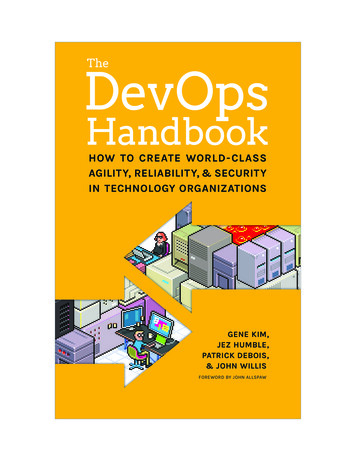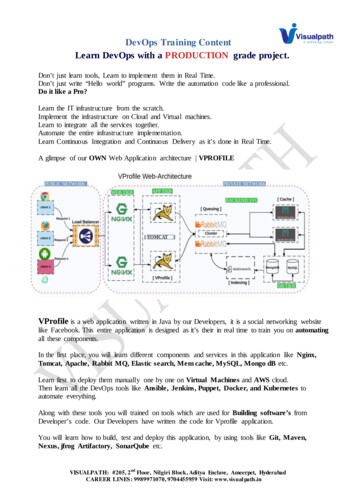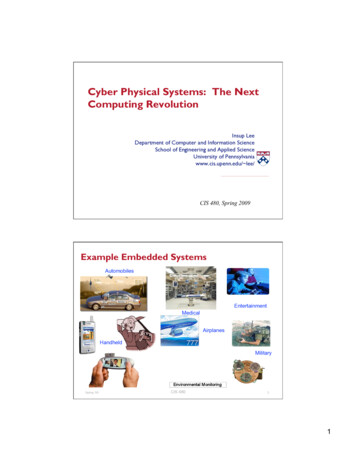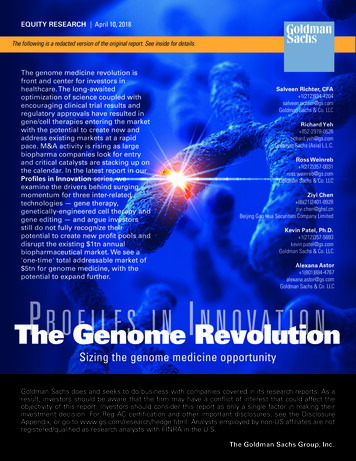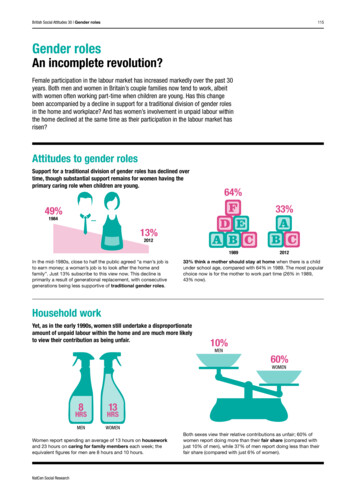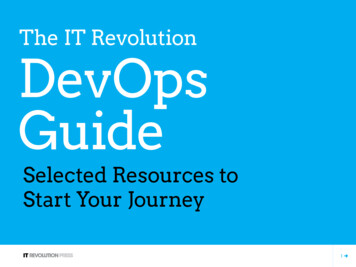
Transcription
DevOpsResourceGuideThe IT RevolutionDevOpsGuideSelected Resources toStart Your Journey1
DevOpsResourceGuideContents3Introduction4 StartingwithDevOps 5Why Do DevOps?11 Where It All Started:10 Deploys per Day:Dev and OpsCooperation at Flickr22 The First Way:System Flowfrom Left to Right 23 Bill Learns aboutBottlenecks29 Peer-Reviewed ChangeApproval Process16 Business ObjectivesSpecific to Scaling DevOps30 Continuous Delivery:Reliable SoftwareReleases through Build,Test, and DeploymentAutomation21 Win-Win Relationshipbetween Dev and Ops35 The Goal: A Process ofOngoing Improvement12 How Does DevOps“Work”?36 DevOps & Lean InLegacy Environments79 Next80 About IT Revolution37 The Second Way:AmplifyFeedback Loops 38 Proactive Monitoring39 If You’re Going forContinuous Deliverywithout Making TestingYour #1, You’re DoingIt Wrong53 The Third Way:CultureExperimentationand Mastery 54 From Agile to DevOpsat Microsoft DeveloperDivision59 Version Control forAll Production Artifacts47 Why Test DataManagement Is Broken60 The High-Velocity Edge:How Market LeadersLeverage OperationalExcellence to Beatthe Competition52 On the Care and Feedingof Feedback Cycles62 Continuous Discussions(#c9d9)42 Conduct BlamelessPostmortems64 Toyota Kata: ManagingPeople for Improvement,Adaptiveness, andSuperior Results83 Acknowledgments65 GrowthandChange 66 How DevOps Can FixFederal Government67 The Secret toScaling DevOps71 Amazon’s Approachto Growth75 High-TrustOrganizational Culture76 Learnings: PracticesWhere We GaugeOur Excellence78 The Five Dysfunctionsof a Team:A Leadership FableSponsors81 The Phoenix Project82 DevOps EnterpriseSummit andThe DevOps Cookbook2
IntroductionDevOpsResourceGuideThe most commonly asked question that we get atIT Revolution is “How do I get started with DevOps?”Rather than try to answer all of these questions ourselves, we decidedto gather the best resources from some of the best thinkers in the field.Our goal for The IT Revolution DevOps Guide: Selected Resources toStart Your Journey is to present the most helpful materials for practitionersto learn and accelerate their own DevOps journey.We reached out to several practitioners that we admire for their best ideason how to get started. In addition, we assembled some of the best materialfrom the vendor community and have highlighted those works as well.We combined these with excerpts from The Phoenix Project, the upcomingDevOps Cookbook, 2014 State of DevOps Survey of Practice, and 2014DevOps Enterprise Summit. You’ll find a collection of essays, book excerpts,videos, survey results, book reviews, and more.We hope you enjoy this collection and find it useful, regardless of whereyou are on your DevOps journey.— GENE KIM AND THE IT REVOLUTION TEAM3
DevOpsResourceGuidennnnnnnnnStartingwithDevOps4
DevOpsResourceGuideWhy Do DevOps?The competitive advantage this capability creates is enormous,enabling faster feature time to market, increased customersatisfaction, market share, and employee productivity andhappiness, as well as allowing organizations to win in themarketplace. Why? Because technology has becomethe dominant value creation process and an increasinglyimportant (and often the primary) means of customeracquisition within most organizations.In contrast, organizations that require weeks or monthsto deploy software are at a significant disadvantage inthe marketplace.StartingwithDevOps5
D hhighTwitter3/weekminuteshighhighTypical enterpriseonce every 9 months months or quarters low/mediumlow/mediumOne of the hallmarks of high performers in any fieldis that they always “accelerate from the rest of the herd.”In other words, the best always get better.This constant and relentless improvement in performanceis happening in the DevOps space, too. In 2009, ten deploysper day was considered fast. Now that is considered merelyaverage. In 2012, Amazon went on record stating that theywere doing, on average, 23,000 deploys per day.StartingwithDevOps6
Business Value of Adopting DevOps PrinciplesInthe 2013 Puppet Labs “State of DevOps Report,”Not only were the organizations doing more work, but theywe were able to benchmark 4,039 IT organizationshad far better outcomes: when the high performers deployedwith the goal of better understanding the health and habitschanges and code, they were twice as likely to be completedof organizations at all stages of DevOps adoption.successfully (i.e., without causing a production outage or serviceThe first surprise was how much the high-performingorganizations using DevOps practices were outperformingtheir non-high-performing peers in agility metrics: 30 more frequent code deployments 8,000 faster code deployment lead timeAnd reliability metrics:DevOpsResourceGuideimpairment), and when the change failed and resulted in anincident, the time required to resolve the incident was twelvetimes faster.This study was especially exciting because it showed empiricallythat the core, chronic conflict can be broken: high performersare deploying features more quickly while providing world-classlevels of reliability, stability, and security, enabling them to outexperiment their competitors in the marketplace. An even more 2 the change success rate 12 faster MTTRIn other words, they were more Agile. They were deployingcode thirty times more frequently, and the time required to gofrom “code committed” to “successfully running in production”was eight thousand times faster. High performers had leadtimes measured in minutes or hours, while lower performershad lead times measured in weeks, months, or even quarters.astonishing fact: delivering these high levels of reliability actuallyrequires that changes be made frequently!In the 2014 study, we also found that not only did these highperformers have better IT performance, they also had significantly better organizational performance as well: they weretwo times more likely to exceed profitability, market share, andproductivity goals, and there are hints that they have significantlybetter performance in the capital markets, as well.StartingwithDevOps 7
What It Feels Like to Live in a DevOps WorldImagineliving in a DevOps world, whereinjects pressure into the system of work to enable organizationalproduct owners, Development, QA,learning and improvement. Everyone dedicates time toIT Operations, and InfoSec work together relentlessly to helpputting those lessons into practice and paying down technicaleach other and the overall organization win. They are enablingdebt. Everyone values nonfunctional requirements (e.g., quality,fast flow of planned work into production (e.g., performingscalability, manageability, security, operability) as much astens, hundreds, or even thousands of code deploys per day),features. Why? Because nonfunctional requirements are justwhile preserving world-class stability, reliability, availability,as important in achieving business objectives, too.and security.We have a high-trust, collaborative culture where everyone isInstead of the upstream Development groups causing chaos forresponsible for the quality of their work. Instead of approvalthose in the downstream work centers (e.g., QA, IT Operations,and compliance processes, the hallmark of a low-trust, command-and InfoSec), Development is spending twenty percent of itsand-control management culture, we rely on peer review totime helping ensure that work flows smoothly through the entireensure that everyone has confidence in the quality of their code.value stream, speeding up automated tests, improving deployment infrastructure, and ensuring that all applications createuseful production telemetry.Furthermore, there is a hypothesis-driven culture, requiringeveryone to be a scientist, taking no assumptions for grantedand doing nothing without measuring. Why? Because weWhy? Because everyone needs fast feedback loops to preventknow that our time is valuable. We don’t spend years buildingproblematic code from going into production and to enable codefeatures that our customers don’t actually want, deployingto quickly be deployed so that any production problems arecode that doesn’t work, or fixing something that isn’t actuallyquickly detected and corrected.the problem. All these factors contribute to our ability toEveryone in the value stream shares a culture that not onlyvalues people’s time and contributions but also relentlesslyDevOpsResourceGuiderelease exciting features to the marketplace that delight ourcustomers and help our organization win.StartingwithDevOps8
DevOpsResourceGuideParadoxically, performing code deployments becomes boring andAt the culminating moment when the feature goes live, no newroutine. Instead of being performed only at night or on weekends,code is pushed into production. Instead, we merely change afull of stress and chaos, we are deploying code throughout thefeature toggle or configuration setting. The new feature is slowlybusiness day, without most people even noticing. And becausemade visible to small segments of customers and automaticallycode deployments happen in the middle of the afternoon insteadrolled back if something goes wrong.of on weekends, for the first time in decades, IT Operations isworking during normal business hours, like everyone else.Only when we have confidence that the feature is working asdesigned do we expose it to the next segment of customers,Just how did code deployment become routine? Because devel-rolled out in a manner that is controlled, predictable, reversible,opers are constantly getting fast feedback on their work: whenand low stress. We repeat until everyone is using the feature.they write code, automated unit, acceptance, and integrationtests are constantly being run in production-like environments,giving us continual assurance that the code and environmentwill operate as designed and that we are always in a deployablestate. And when the code is deployed, pervasive productionmetrics demonstrate to everyone that it is working and thecustomer is getting value.Even our highest-stakes feature releases have become routine.How? Because at product launch time, the code deliveringthe new functionality is already in production. Months priorBy doing this, we not only significantly reduce deployment riskbut also increase the likelihood of achieving the desired businessoutcomes, as well. Because we can do deployments quickly,we can do experiments in production, testing our businesshypotheses for every feature we build. We can iteratively testand refine our features in production, using feedback fromour customers for months, and maybe even years.It is no wonder that we are out-experimenting our competitionand winning in the marketplace.to the launch, Development has been deploying code intoAll this is made possible by DevOps, a new way that Development,production, invisible to the customer, but enabling the featureTest, and IT Operations work together, along with everyoneto be run and tested by internal staff.else in the IT value stream.StartingwithDevOps 9
DevOps Is the Manufacturing Revolution of Our AgeTheprinciples behind DevOps work patterns are theIn order to protect sales commitments, the product sales forcesame principles that transformed manufacturing.wanted lots of inventory on hand, so that customers couldInstead of optimizing how raw materials are transformedalways get products when they wanted them. However, in orderinto finished goods in a manufacturing plant, DevOps showsto reduce costs, plant managers wanted to reduce inventoryhow we optimize the IT value stream, converting businesslevels and work in process (WIP).needs into capabilities and services that provide value forour customers.During the 1980s, there was a very well-known core, chronicconflict in manufacturing:DevOpsResourceGuideBecause one can’t simultaneously increase and decrease theinventory levels at the plant, sales managers and plant managerswere locked in a chronic conflict.They were able to break the conflict by adopting Lean principles, Protect sales commitmentssuch as reducing batch sizes, reducing work in process, and Control manufacturing costsshortening and amplifying feedback loops. This resultedin dramatic increases in plant productivity, product quality,The principles behind DevOps workpatterns are the same principles thattransformed manufacturing. DevOpsshows how we optimize the IT valuestream, converting business needs intocapabilities and services that providevalue for our customers. 2015 IT Revolution i trevolution.comand customer satisfaction.In the 1980s, average order lead times were six weeks, withless than 70 percent of orders being shipped on time. By 2005,average product lead times had dropped to less than threeweeks, with more than 95 percent of orders being shipped ontime. Organizations that were not able to replicate these performance breakthroughs lost market share, if they didn’t go outof business entirelyStartingwithDevOps 10
DevOpsResourceGuideVideoWhere It All Started:10 Deploys per Day: Dev and Ops Cooperation at Flickrpresentation by John Allspaw and Paul Hammond at Velocity 2009This talk is widely credited for showing the world what DevOps could achieve,showing how one of the largest Internet sites was routinely deployingfeatures into production at a rate scarcely imaginable for typical IT organizationswho were doing quarterly or annual updates.StartingwithDevOps11
DevOpsResourceGuideEssayHow Does DevOps “Work”?from Navigating DevOpsLike all cultures, DevOps has many variations on the theme.However, most observers would agree that the following capabilities are common to virtually all DevOps cultures: collaboration,automation, continuous integration, Continuous Delivery, contin-New Relic is a software analytics company thatmakes sense of billions of data points aboutmillions of applications in real time. New Relic’suous testing, continuous monitoring, and rapid remediation.Collaborationcomprehensive SaaS-based solution providesInstead of pointing fingers at each other, development and IT op-one powerful interface for web and nativeerations work together (no, really). While the disconnect betweenmobile applications and consolidates theperformance monitoring data for any chosenthese two groups created the impetus for its creation, DevOpsextends far beyond the IT organization, because the need for collaboration extends to everyone with a stake in the delivery oftechnology in your environment. More thansoftware (not just between Dev and Ops, but all teams, including250,000 users trust New Relic to tap intotest, product management, and executives).the billions of real-time metrics from insidetheir production software.StartingwithDevOps12
DevOpsResourceGuideSuccessful DevOps requires business, development, QA, and opera-code base, it can be identified and corrected as soon as possible.tions organizations to coordinate and play significant roles at differentThe usual rule is for each team member to submit work on a dailyphases of the application lifecycle. It may be difficult, even impossible,(or more frequent) basis and for a build to be conducted with eachto eliminate silos, but collaboration is essential.significant change.AutomationThe continuous integration principle of Agile development has acultural implication for the development group. Forcing developers to integrate their work with other developers frequently—atDevOps relies heavily on automation—and that means you needleast daily—exposes integration issues and conflicts much earliertools. Tools you build. Tools you buy. Open source tools. Proprietarythan is the case with waterfall development. However, to achievetools. And those tools are not just scattered around the lab willy-this benefit, developers have to communicate with each othernilly: DevOps relies on toolchains to automate large parts of themuch more frequently—something that runs counter to the imageend-to-end software development and deployment process.of the solitary genius coder working for weeks or months on aCaveat: because DevOps tools are so amazingly awesome,there’s a tendency to see DevOps as just a collection of tools.While it’s true that DevOps relies on tools, DevOps is much moremodule before she is “ready” to send it out in the world. That seedof open, frequent communication blooms in DevOps.than that.Continuous TestingContinuous IntegrationThe testing piece of DevOps is easy to overlook—until you getburned. As one industry expert puts it, “The cost of quality is theYou usually find continuous integration in DevOps culturescost of failure.” While continuous integration and delivery get thebecause DevOps emerged from Agile culture, and continuouslion’s share of the coverage, continuous testing is quietly findingintegration is a fundamental tenet of the Agile approach.its place as an equally critical piece of DevOps.Continuous integration (CI) is a software engineering practice inContinuous testing is not just a QA function. In fact, it starts inwhich isolated changes are immediately tested and reported onthe development environment. The days are over when develop-when they are added to a larger code base. The goal of CI is toers could simply throw the code over the wall to QA and say, “Haveprovide rapid feedback so that if a defect is introduced into theat it.” In a DevOps environment, everyone is involved in testing.StartingwithDevOps13
DevOpsResourceGuideDevelopers make sure that, along with delivering error-free code,The payoff from continuous testing is well worth the effort.they provide test data sets. They also help test engineers config-The test function in a DevOps environment helps developers toure the testing environment to be as close to the production envi-balance quality and speed. Using automated tools reduces the costronment as possible.of testing and allows test engineers to leverage their time moreOn the QA side, the big need is speed. After all, if the QA cycletakes days and weeks, you’re right back into a long, drawn-outeffectively. Most importantly, continuous testing shortens testcycles by allowing integration testing earlier in the process.waterfall kind of schedule. Test engineers meet the challenge ofContinuous testing also eliminates testing bottlenecks throughquick turnaround by not only automating much of the test processvirtualized dependent services, and it simplifies the creation of vir-but also redefining test methodologies:tualized test environments that can be easily deployed, shared, andupdated as systems change. These capabilities reduce the cost ofRather than making test a separate and lengthy sequence in the largerprovisioning and maintaining test environments, and they shortendeployment process, Continuous Delivery practitioners roll out smalltest cycle times by allowing integration testing earlier in life cycle.upgrades almost constantly, measure their performance, and quicklyroll them back as needed.Although it may come as a surprise, the operations function hasan important role to play in testing and QA:Operations has access to production usage and load patterns. Thesepatterns are essential to the QA team for creating a load test thatproperly exercises the application.Operations can also ensure that monitoring tools are in place andRather than making test a separateand lengthy sequence in the largerdeployment process, Continuous Deliverypractitioners roll out small upgradesalmost constantly, measure theirperformance, and quickly roll themback as needed.test environments are properly configured. They can participate infunctional, load, stress, and leak tests and offer analysis based ontheir experience with similar applications running in production.StartingwithDevOps14
DevOpsResourceGuideContinuous DeliveryContinuous MonitoringIn the words of one commentator, “Continuous Delivery is nothingGiven the sheer number of releases, there’s no way to implementbut taking this concept of continuous integration to the next step.”the kind of rigorous pre-release testing that characterizes water-Instead of ending at the door of the development lab, continuousfall development. Therefore, in a DevOps environment, failuresintegration in DevOps extends to the entire release chain, includ-must be found and fixed in real time. How do you do that? A biging QA and operations. The result is that individual releases are farpart is continuous monitoring.less complex and come out much more frequently.According to one pundit, the goals of continuous monitoring areThe actual release frequency varies greatly depending on theto quickly determine when a service is unavailable, understandcompany’s legacy and goals. For example, one Fortune 100 com-the underlying causes, and most importantly, apply these learn-pany improved its release cycle from once a year to once a quar-ings to anticipate problems before they occur. In fact, some moni-ter—a release rate that seems glacial compared to the hundreds oftoring experts advocate that the definition of a service mustreleases an hour achieved by Amazon.include monitoring—they see it as integral to service delivery.Exactly what gets released varies as well. In some organizations,Like testing, monitoring starts in development. The same toolsQA and operations triage potential releases: many go directly tothat monitor the production environment can be employed in devel-users, some go back to development, and a few simply are notopment to spot performance problems before they hit production.deployed at all. Other companies—Flickr is a notable example—Two kinds of monitoring are required for DevOps: serverpush everything that comes from developers out to users andmonitoring and application performance monitoring. Monitoringcount on real-time monitoring and rapid remediation to minimizediscussions quickly get down to tools discussions, because there isthe impact of the rare failure.no effective monitoring without the proper tools. For a list of DevOps tools (and more DevOps-related content), visit New Relic’s DevOps Hub.Download the entire Navigating DevOps ebook. 2015 New Relic, Inc n ewrelic.com/DevOpsStartingwithDevOps15
DevOpsResourceGuideBook ExcerptBusiness Objectives Specificto Scaling DevOpsThe fundamental Agile principle of releasing frequently tends to get overlookedor ignored by organizations that approach Agile transformations by scalingteams. It has been so overlooked by these organizations that new practices calledDevOps and Continuous Delivery (CD) have begun to emerge to address this gap.In DevOps, the objective is to blur the lines between Development and Operationsso that new capabilities flow easier from Development into Production. On a smallscale, blurring the lines between Development and Operations at the team levelimproves the flow. In large organizations, this tends to require more structuredapproaches like CD. Applying these concepts at scale is typically the source of thebiggest breakthroughs in improving the efficiency and effectiveness of softwaredevelopment in large organizations, and it should be a key focus of any large-scaletransformation and is a big part of this book.In this book we purposefully blur the line between the technical solutions like CD andExcerpt fromLeading the Transformation:Applying Agile andDevOps Principles at Scalethe cultural changes associated with DevOps under the concept of applying DevOpsprinciples at scale, because you really can’t do one without the other. DevOps and CDare concepts that are gaining a lot of momentum in the industry because they are ad-Gary Gruver and Tommy Mouserdressing the aforementioned hole in the delivery process. That said, since these ideas areIT Revolution, 2015so new, not everyone agrees on their definitions.StartingwithDevOps16
DevOpsResourceGuideBook ExcerptCD tends to cover all the technical approaches for im-that way or tell them that it broke these other things, theyproving code releases and DevOps tends to be focused onare likely to say, “What code?,” “When?,” or “Are you sure itthe cultural changes. From our perspective you really can’twas me?” If instead the system was able to provide goodmake the technical changes without the cultural shifts.feedback to the developer within a few hours or less, theyTherefore, for the proposes of this book we will definewill more likely think about their coding approach and willDevOps as processes and approaches for improving thelearn from the mistake.efficiency of taking newly created code out of develop-The objective here is to change the feedback process soment and to your customers. This includes all the techni-that rather than beating up the developer for making mis-cal capabilities like CD and the cultural changes associatedtakes they don’t even remember, there is a real-time pro-with Development and Operations groups working togeth-cess that helps them improve. Additionally, you want toer better.move this feedback from simply validating the code toThere are five main objectives that are helpful for execu-making sure it will work efficiently in production so you cantives to keep in mind when transforming this part of the de-get everyone focused on delivering value all the way to thevelopment process so they can track progress and havecustomer. Therefore, as much as possible you want to ensurea framework for prioritizing the work.the feedback is coming from testing in an environment thatis as much like production as possible. This helps to start the1. Improve the quality and speed of feedbackfor developerscultural transformation across Development and Operationsby aligning them on a common objective.The Operations team can ensure their concerns are ad-Developers believe they have written good code that meetsdressed by starting to add their release criteria to these testits objectives and feel they have done a good job until theyenvironments. The Development teams then start to learnget feedback telling them otherwise. If this feedback takesabout and correct issues that would occur in production be-days or weeks to get to them, it is of limited value to the de-cause they are getting this feedback on a daily basis when itvelopers’ learning. If you approach a developer weeks afteris easy to fix. Executives must ensure that both Developmentthey have written the code and ask them why they wrote itand Operations make the cultural shift of using the sameStartingwithDevOps17
DevOpsResourceGuideBook Excerpttools and automation to build, test, and deploy if the trans-tion can go down dramatically because the historic effort offormation is going to be successful.manually running the entire regression suite and finding thedefects after development is complete has been eliminated.2. Reduce the time and resources required to goIdeally, for very mature organizations, this step enables youfrom functionality complete or release branchingto keep trunk quality very close to production quality, suchto productionthat you can use continuous deployment techniques todeploy into production with multiple check-ins a day.The next objective is reducing, as much as possible, the timeThis goal of a production-level trunk is pretty lofty forand resources required to go from functionality complete ormost traditional organizations, and lots of businesses cus-release branching to production. For large, traditional orga-tomers would not accept overly frequent releases. Workingnizations, this can be a very lengthy and labor intensive pro-towards this goal, though, enables you to support delivery ofcess that doesn’t add any value and makes it impossible tothe highest-priority features on a regular cadence defined byrelease code economically and on a more frequent basis. Thethe business instead of one defined by the development pro-work in this phase of the program is focused on finding andcess capabilities. Additionally, if the developers are workingfixing defects to bring the code base up to release quality.on a development trunk that is very unstable and full of de-Reducing this time requires automating your entire regres-fects, the likely reaction to a test failure is “that’s not my fault,sion suite and implementing all-new testing so that it can beI’m sure that defect was already there.” On the other hand, ifrun every day during the development phase to provide rap-the trunk is stable and of high quality, they are much moreid feedback to the developers. It also requires teaching yourlikely to realize that a new test failure may in fact be the re-Development organization to add new code without break-sult of the code they just checked in. With this realizationing existing functionality, such that the main code branch isyou will see the Development community begin to take own-always much closer to release quality.ership for the quality of the code they commit each day.Once you have daily full-regression testing in place, thetime from functionality complete or branch cut to producStartingwithDevOps18
DevOpsResourceGuideBook Excerpt3. Improve the repeatability of the build,4. Develop an automated deployment processdeploy, and test processthat will enable you to quickly and efficiently findany deployment or environment issuesIn most large, traditional organizations, the repeatability ofthe entire build, test, and deploy process can be a hugeDepending on the type of application, the deployment pro-source of inefficiencies. For small organizations with inde-cess may be as simple as FTPing a file to a printer or aspendent applications, a few small Scrum teams workingcomplex as deploying and debugging code to hundreds ortogether can easily accomplish this process improvement.thousands of servers. If the application requires deployingFor large organizations that have large groups of engineers
We combined these with excerpts from The Phoenix Project, the upcoming DevOps Cookbook, 2014 State of DevOps Survey of Practice, and 2014 DevOps Enterprise Summit. You’ll find a collection of essays, book excerpts, videos, survey results, book reviews, and more. We hope you enjo
